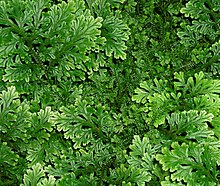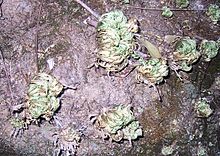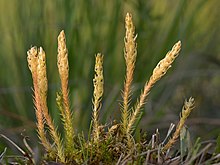Selaginella
| Spikemoss Temporal range:
| |
|---|---|

| |
| Scientific classification | |
| Kingdom: | Plantae |
| Clade: | Tracheophytes |
| Clade: | Lycophytes |
| Class: | Lycopodiopsida |
| Order: | Selaginellales Prantl |
| Family: | Selaginellaceae Willk. |
| Genus: | Selaginella P. Beauv. |
| Type species | |
| Selaginella selaginoides | |
| Species | |
|
See text. | |
| Synonyms | |
| |


Selaginella,also known asspikemossesorlesser clubmossesis a genus oflycophyte.It is usually treated as the only genus in the familySelaginellaceae,with over 750 known species.
This family is distinguished fromLycopodiaceae(the clubmosses) by having scale-leaves bearing a ligule and by havingspores of two types.They are sometimes included in an informal paraphyletic group called the "fern allies".The speciesS. moellendorffiiis an importantmodel organism.Its genome has been sequenced by theUnited States Department of Energy'sJoint Genome Institute.[1]The nameSelaginellawas erected by Palisot de Beauvois solely for the speciesSelaginella selaginoides,which turns out (with the closely relatedSelaginella deflexa) to be a clade that is sister to all otherSelaginellas,so any definitive subdivision of the species into separate genera leaves two taxa inSelaginella,with the hundreds of other species in new or resurrected genera.
Selaginellaoccurs mostly in the tropical regions of the world, with a handful of species to be found in the arctic-alpine zones of both hemispheres.[2]Fossils assignable to the modern genus are known spanning over 300 million years from the LateCarboniferousto the present.[3]
Description
[edit]Selaginellaspecies are creeping or ascendant plants with simple, scale-like leaves (microphylls) on branching stems from which roots also arise. The stems are aerial, horizontally creeping on the substratum (as inSelaginella kraussiana), sub-erect (Selaginella trachyphylla) or erect (as inSelaginella erythropus). The vascularstelesare polystelicprotosteles.Stem section shows the presence of more than two protosteles. Each stele is made up ofdiarch(having two strands of xylem[4]) andexarch(growing outward in)xylems.[citation needed]The steles are connected with the cortex by means of many tube-like structures calledtrabeculae,which are modified endodermal cells withcasparian stripson their lateral walls.[citation needed]The stems contain no pith.[citation needed]
InSelaginella,each microphyll and sporophyll has a small scale-like outgrowth called aliguleat the base of the upper surface.[5]: 7 The plants areheterosporouswith spores of two different size classes, known as megaspores and microspores.[6]
Unusual for the lycopods, which nearly always havemicrophyllswith a single unbranched vein, the microphylls of a fewSelaginellaspecies contain a branched vascular trace.[7]
Under dry conditions, some species ofSelaginellacan survive dehydration. In this state, they may roll up into brown balls and be uprooted, but can rehydrate under moist conditions, become green again and resume growth. This phenomenon is known aspoikilohydry,and poikilohydric plants such asSelaginella bryopterisare sometimes referred to asresurrection plants.[8]
There is no evidence ofwhole genome duplicationin Selaginella's evolutionary history. Instead they have gone through tandem gene duplications, which is particularly noticeable in genes relevant for desiccation tolerance.[9][jargon]
Taxonomy
[edit]This sectionneeds additional citations forverification.(April 2021) |
Some scientists still place the Selaginellales in the classLycopodiopsida(often misconstructed as "Lycopsida" ).[citation needed][10][11]Some modern authors recognize three generic divisions ofSelaginella:Selaginella,BryodesmaSojak 1992,andLycopodioidesBoehm 1760.Lycopodioideswould include the North American speciesS. apodaandS. eclipes,whileBryodesmawould includeS. rupestris(asBryodesma rupestre).Stachygynandrumis also sometimes used to include the bulk of species.[citation needed]
The first major attempt to define and subdivide the group was byPalisot de Beauvois[12]in 1803–1805. He established the genusSelaginellaas a monotypic genus, and placed the bulk of species inStachygynandrum.Gymnogynumwas another monotypic genus, but that name is superseded by his own earlier name ofDidiclis.This turns out, today, to be a group of around 45–50 species also known as theArticulatae,since his genusDidiclis/Gymnogynumwas based onSelaginella plumosa.He also described the genusDiplostachyumto include a group of species similar toSelaginella apoda.Springinflated the genusSelaginellato hold all selaginelloid species four decades later.
Phylogenetic studies by Korall & Kenrick[13][14]determined that theEuselaginellagroup, comprising solely the type species,Selaginella selaginoidesand a closely related Hawaiian species,Selaginella deflexa,is a basal and anciently diverging sister to all otherSelaginellaspecies. Beyond this, their study split the remainder of species into two broad groups, one including theBryodesmaspecies, theArticulatae,sectionEricetorumJermyand others, and the other centered on the broadStachygynandrumgroup.
In 2023, Zhou & Zhang suggested that the genus should be broken up into 19 different genera.[15]
| Walton & Aston 1938[16] | Weststrand & Korall 2016[17] |
|---|---|
|
|
Zhang & Zhou, 2015 classification
[edit]- subgenus:SelaginellaType:S. selaginoides(L.) P.Beauv. ex Mart. & Schrank
- subgenus:BoreoselaginellaType:S. sanguinolenta(L.) Spring
- subgenus:EricetorumType:S. uliginosa(Labill.) Spring
- section:LyalliaType:S. uliginosa(Labill.) Spring
- section:MyosurusType:S. myosurusAlston
- section:MegalosporarumType:S. exaltata(Kunze) Spring
- section:ArticulataeType:S. kraussiana(Kunze) A.Braun
- section:HomoeophyllaeType:S. rupestris(L.) Spring(=BryodesmaSojakorTetragonostachysJermy)
- section:LepidophyllaeType:S. lepidophylla(Hook. & Grev.) Spring
- subgenus:PulviniellaType:S. pulvinata(Hook. & Grev.) Maxim
- subgenus:HeterostachysType:S. heterostachysBaker
- section:OligomacrosporangiataeType:Selaginella uncinata(Desv. ex Poir.) Spring
- section:AuriculataeType:S. douglasii(Hook. & Grev.) Spring
- section:HomostachysType::S. helvetica(L.) Link
- section:TetragonostachyaeType:S. proniflora(L.) Baker
- section:HeterostachysType:S. brachystachya(Hook. & Grev.) Spring
- subgenus:StachygynandrumType:S. flabellata(L.) Spring
- section:PlagiophyllaeType:S. biformisA.Braun ex Kuhn
- section:CircinataeType:S. involvens(Sw.) Spring
- section:HeterophyllaeType:S. flexuosaSpring
- section:AustroamericanaeType:S. hartwegianaSpring
- section:PallescentesType:S. pallescens(C.Presl)Spring
- section:ProceresType:S. oaxacanaSpring
- section:AscendentesType:S. alopecuroidesBaker
| Zhang & Zhou 2015[18] | Zhou & Zhang 2023[15] | |||||||||||||||||||||||||||||||||||||||||||||||||||||||||||||||||||||||||||||||||||||||||||||||||||||||||||||||||||||||||||||||||||||||||||||||||||||||||||||||||||||||||||||||||||||||||||||||||||||||||||||||||||||||||||||||||||||||||||||||||||||||||||||||||||||||||||||||||||||||||||||||||||||||||
|---|---|---|---|---|---|---|---|---|---|---|---|---|---|---|---|---|---|---|---|---|---|---|---|---|---|---|---|---|---|---|---|---|---|---|---|---|---|---|---|---|---|---|---|---|---|---|---|---|---|---|---|---|---|---|---|---|---|---|---|---|---|---|---|---|---|---|---|---|---|---|---|---|---|---|---|---|---|---|---|---|---|---|---|---|---|---|---|---|---|---|---|---|---|---|---|---|---|---|---|---|---|---|---|---|---|---|---|---|---|---|---|---|---|---|---|---|---|---|---|---|---|---|---|---|---|---|---|---|---|---|---|---|---|---|---|---|---|---|---|---|---|---|---|---|---|---|---|---|---|---|---|---|---|---|---|---|---|---|---|---|---|---|---|---|---|---|---|---|---|---|---|---|---|---|---|---|---|---|---|---|---|---|---|---|---|---|---|---|---|---|---|---|---|---|---|---|---|---|---|---|---|---|---|---|---|---|---|---|---|---|---|---|---|---|---|---|---|---|---|---|---|---|---|---|---|---|---|---|---|---|---|---|---|---|---|---|---|---|---|---|---|---|---|---|---|---|---|---|---|---|---|---|---|---|---|---|---|---|---|---|---|---|---|---|---|---|---|---|---|---|---|---|---|---|---|---|---|---|---|---|---|---|---|---|---|---|---|---|---|---|---|---|---|---|---|---|---|---|
|
|
Species
[edit]

There are about 750 known species ofSelaginella.[19]They show a wide range of characters; the genus is overdue for a revision which might include subdivision into several genera.[citation needed]Species of spikemoss include:
- Selaginella apoda– meadow spikemoss; easternNorth America
- Selaginella arizonicaMaxon– west Texas to Arizona and Sonora, Mexico
- Selaginella asprella
- Selaginella bifida–Rodrigues Island
- Selaginella biformis
- Selaginella bigelovii
- Selaginella braunii– Braun's spikemoss;China
- Selaginella bryopteris– sanjeevani;India
- Selaginella canaliculata– clubmoss;southeast Asia,Maluku Islands
- Selaginella carinata
- Selaginella cinerascens
- Selaginella densa– lesser spikemoss; western North America
- Selaginella denticulata
- Selaginella eclipes– hidden spikemoss; eastern North America
- Selaginella elmeri
- Selaginella eremophilaMaxon
- Selaginella erythropus
- Selaginella galotteii
- Selaginella gigantea– From Venezuela.
- Selaginella hansenii
- Selaginella kraussiana– Krauss's spikemoss;Africa,Azores
- Selaginella lepidophylla– resurrection plant, dinosaur plant, and flower of stone;Chihuahuan Desert,North America
- Selaginella martensii– variegated spikemoss
- Selaginella moellendorffii
- Selaginella oregana
- Selaginella plana– Asian spikemoss; tropicalAsia
- Selaginella poulteri
- Selaginella pulcherrima
- Selaginella rupestris– rock spikemoss, festoon pine, and northern Selaginella (eastern North America)
- Selaginella rupincolaUnderw.– west Texas to Arizona and Sonora, Mexico
- Selaginella selaginoides– lesser clubmoss; north temperateEurope,AsiaandNorth America)
- Selaginella sericeaA.Braun–Ecuador
- Selaginella serpens
- Selaginella sibirica
- Selaginella stellata– starry spikemoss; Mexico,Central America
- Selaginella substipitata
- Selaginella tamariscina
- Selaginella tortipila
- Selaginella uliginosa–Australia
- Selaginella umbrosa
- Selaginella uncinata– peacock moss, peacock spikemoss, blue spikemoss
- Selaginella underwoodiiHieron.– west Texas to Wyoming and west into Arizona
- Selaginella wallacei
- Selaginella watsonii
- Selaginella willdenowii– Willdenow's spikemoss, peacock fern; southeast Asia
A few species ofSelaginellaaredesertplants known as "resurrection plants", because they curl up in a tight, brown or reddish ball during dry times, and uncurl and turn green in the presence of moisture. Other species are tropicalforestplants that appear at first glance to beferns.
Cultivation
[edit]A number ofSelaginellaspecies are popular plants for cultivation, mostly tropical species. Some of the species popularly cultivated and actively available commercially include:
- S. kraussiana:golden clubmoss
- S. martensii:frosty fern
- S. moellendorffii:gemmiferous spikemoss
- S. erythropus:red selaginella or ruby-red spikemoss
- S. uncinata:peacock moss
- S. lepidophylla:resurrection plant
- S. braunii:arborvitae fern
References
[edit]- ^"Selaginella moellendorffiiv1.0 ".Joint Genome Institute.United States Department of Energy.2007.Retrieved2009-04-08.
- ^"Selaginella kraussiana | PlantZAfrica".
- ^Bek, Jiří; Libertín, Milan; Drábková, Jana (June 2009)."Selaginella labutae sp. nov., a new compression herbaceous lycopsid and its spores from the Kladno–Rakovník Basin, Bolsovian of the Czech Republic".Review of Palaeobotany and Palynology.155(3–4): 101–115.Bibcode:2009RPaPa.155..101B.doi:10.1016/j.revpalbo.2007.12.010.
- ^"Diarch".The Free Dictionary.
- ^Stace, C. A.(2010).New Flora of the British Isles(Third ed.). Cambridge, U.K.: Cambridge University Press.ISBN9780521707725.
- ^Petersen, Kurt B.; Burd, Martin (2018)."The adaptive value of heterospory: Evidence from Selaginella".Evolution.72(5): 1080–1091.doi:10.1111/evo.13484.ISSN1558-5646.PMID29645092.S2CID4800398.
- ^Wagner, Warren H.; Beitel, Joseph M.; Wagner, Florence S. (1982-11-19)."Complex Venation Patterns in the Leaves of Selaginella: Megaphyll-Like Leaves in Lycophytes".Science.218(4574): 793–794.Bibcode:1982Sci...218..793W.doi:10.1126/science.218.4574.793.ISSN0036-8075.PMID17771037.S2CID44904740.
- ^Liberty Hyde Bailey (1916).The Standard Cyclopedia of Horticulture.Vol. 5. The Macmillan company. pp. 2920–2921, 3639.
- ^VanBuren, Robert; Ching, Man Wai; Ou, Shujun; Pardo, Jeremy; Bryant, Doug; Jiang, Ning; Mockler, Todd C.; Edger, Patrick; Michael, Todd P. (2018)."Extreme haplotype variation in the desiccation- tolerant clubmossSelaginella lepidophylla".Nature Communications.9(13): 13.Bibcode:2018NatCo...9...13V.doi:10.1038/s41467-017-02546-5.PMC5750206.PMID29296019.
- ^Clugston, M. (2014).Dictionary of Science(4th ed.). London: Penguin Reference Library. p. 743.ISBN978-0-141-98682-1.
- ^Walker, Peter (1992).Chambers Science and Technology Dictionary(4th ed.). Edinburgh NewYork: Chambers. p. 999.ISBN0-550-13239-2.
- ^Palisot de Beauvois (1805):Prodrome des cinquième et sixième familles de l'Æthéogamie, les mousses, les lycopodes.
- ^Korall, P. & Kenrick, P. (2002), "Phylogenetic relationships in Selaginellaceae based onrbcLsequences ",American Journal of Botany,89(3): 506–17,doi:10.3732/ajb.89.3.506,PMID21665649
- ^Korall & Kenrick (2004): The phylogenetic history of Selaginellaceae based on DNA sequences from the plastid and nucleus: extreme substitution rates and rate heterogeneity.Molecular Phylogenetics and Evolution,Volume 31, Issue 3, June 2004, Pages 852–864
- ^abZhou, Xin-Mao; Zhang, Li-Bing (2023), "Phylogeny, character evolution, and classification of Selaginellaceae (lycophytes)",Plant Diversity,45(6): 630–684,Bibcode:2023PlDiv..45..630Z,doi:10.1016/j.pld.2023.07.003,PMC10772194,PMID38197007
- ^Verdoorn, F., ed. (1938): Manual of Pteridology: J. Walton and A. H. G. Alston, Lycopodinae, pp. 500–506. Martinus Nijhoff, The Hague. 640pp, HB.
- ^Weststrand, Stina; Korall, Petra (2016),"A subgeneric classification ofSelaginella(Selaginellaceae) ",American Journal of Botany,103(12): 2160–2169,doi:10.3732/ajb.1600288,PMID27999080
- ^abZhou, Xin-Mao; Zhang, Li-Bing (2015), "A classification ofSelaginella(Selaginellaceae) based on molecular (chloroplast and nuclear), macromorphological, and spore features ",Taxon,64(6): 1117–1140,doi:10.12705/646.2,S2CID90451945
- ^Christenhusz, M. J. M. & Byng, J. W. (2016)."The number of known plants species in the world and its annual increase".Phytotaxa.261(3): 201–217.doi:10.11646/phytotaxa.261.3.1.
External links
[edit] Media related toSelaginellaat Wikimedia Commons
Media related toSelaginellaat Wikimedia Commons Data related toSelaginellaat Wikispecies
Data related toSelaginellaat Wikispecies
